Allium tuberosum
Common
Names: garlic chives, Chinese leeks, Chinese chives, flat chives
Botanical
Family: Amaryllidaceae, the amaryllis Family
Description
Garlic
chives is an allium grown for its leaves, and not its little bulb. The
tough, fibrous bulb is elongate and originates from a stout rhizome
(underground stem). The gray-green leaves are flat and grasslike, to 15
in (38 cm) long, and about 0.3 in (0.8 cm) wide. The plant grows in a
clump and the leaves bend down under their own weight. The showy
inflorescence stands above the leaf clump on 1-2 ft (0.3-0.6 m) stalks
and consists of a rounded umbel, 2 in (5 cm) across, with many small
creamy white, star-shaped, fragrant flowers. Each perianth segment
(petal and sepal) has a brown stripe. The unique flavor of garlic
chives is both sweet and garlicky. Several cultivars are available in
Asia, including some grown for the flower stalks, which are also eaten.
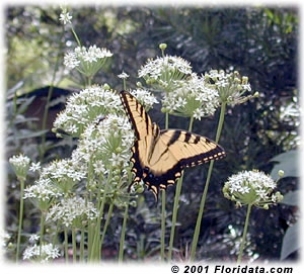 | | A tiger swallowtail butterfly enjoys a dinner of garlic chive nectar. |
Location
Originally from SE Asia, garlic chives (Allium tuberosum) has become an invasive weed in some parts of Europe and North America.
Culture
Garlic
chives is a fast growing and fast spreading perennial that needs to be
divided every 3-4 years. Maintain it as a permanent crop, and harvest
individual leaves as needed.
Light: Full sun to light shade.
Moisture: Garlic chives can tolerate drought, and thrives with normal garden watering.
Hardiness: USDA Zones 4 - 8.
Propagation: Propagate by seed or by dividing the clumps.
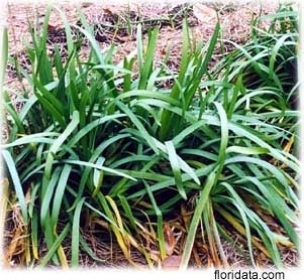 | Steve grows his garlic chives in the vegetable garden where they can be conveniently plucked for positioning atop baked pototoes
|
Usage
Garlic
chives spreads by rhizomes and by self-seeding, and makes an excellent
ground cover or edging plant. Garlic chives is equally at home in the
herb garden, the vegetable garden, a flower bed, or as an edging along
a mixed border or along a path. It takes the heat better than true
chives (Allium schoenoprasum), and doesn't die back in summer. Whether
grown as an ornamental or for food, garlic chives usually is treated as
a semi-permanent crop, and left in place for several years.
The
flavor, at once sweet and garlic-like, is useful in salads, stir fries
and soups. It goes well in egg dishes and with fish. I use garlic
chives raw in salads and as a substitute for chives. The flavor is best
in winter, especially after a few frosts. Younger leaves are more
tender than older ones. In China, garlic chives usually is cooked as a
vegetable potherb rather than used as a flavoring in other dishes. The
Chinese often blanch alternate crops of garlic chives. Blanching causes
the garlic chives to yellow and gives them a softer texture. Typically,
the garlic chives are cut back, then shaded for 3-4 weeks before
harvesting the pale yellow leaves. A simple way to do this is to cover
with a layer of straw.
Features
Some authorities
place the onions, garlics, leeks and their relatives in a family of
their own, the Alliaceae, and others put them in the lily family, the
Liliaceae. There are about 400 species in the genus Allium, including
some magnificent ornamentals.
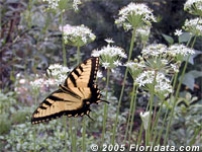 | 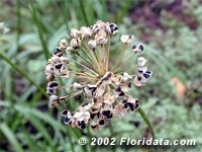 | 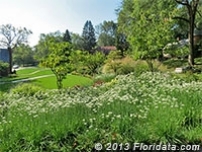 | | Garlic chives in bloom | Seedhead of the garlic chive | A late summer bed of blooming garlic chives |
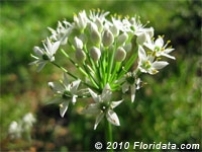 | 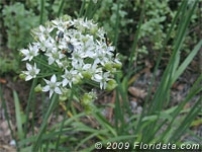 | Garlic chive flowers
| Garlic chive flower cluster |
Back to
Garlic Chives Page
|






